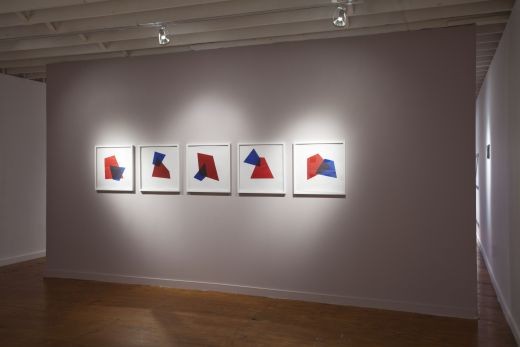
Luis Romero, Dependientes, 2015. Lithographic ink monotype on paper, 60 x 60 cm each. Courtesy Alejandra von Hartz Gallery
SEPTEMBER 10–NOVEMBER 13, 2015
At the Alejandra Von Hartz Gallery, Luis Romero’s use of unassuming arrangements of materials and mediums across a varied body of works—developed in distinct series—brings the viewer into a multifaceted dialogue. The Parcial series—dark, ominous, an opaque vision annulled—features amorphous black globules confined to strictly defined cells, from which one can’t help but think they are trying to break free.
Each work featuring concentric polygons in the Dependientes series has a juxtaposed partner in the related Independientes series. This partnership among the works plays with matters of perception and creates a narrative that touches on the artist’s unique iconography, systems of geometry, and the tension between word and image. As the title might suggest, one series cannot live without the other, while the latter is fully capable of sovereignty. Romero expressed to me his desire to create a meta-language and nowhere else in this show is that more apparent.
THEO RODINO (MIAMI RAIL): Does the show have a thematic focus, on form and balance?
LUIS ROMERO: The exhibition in general, despite the formality of the works, has no speech on topics such as balance. It’s not so much about forms, but meta-language, or an analogy in order to describe personal relationships.
RAIL: Do you feel the series aspect of some of your work adds to its overall impact?
ROMERO: I think that often a theme or idea does not end with a single image or series, and as an artist I’m interested in exploring the many opportunities that the works hand to you—and their consequences. I think, for example, that in the Dependientes and Independientes series this feature is very important. There, the sequence or communication between each of the pieces brings us balance and tension—perhaps in this one piece this will be noticed.
RAIL: How has your work as director of Oficina no. 1, the contemporary art space in Caracas, changed the way you approach your own art?
ROMERO: I differ on the term that you used: “change.” Instead, I rather prefer to use the term “transformed,” and I think certainly it has shaped me. I’m sure if I had another profession, such as pilot or scientist, for example, that would have generated also other ways to interact with art. The chance to build rela- tionships with colleagues and to be so close to their work and ideas, generates a fruitful dialogue and confronts us as artists.
RAIL: With some of your pieces, like Lego-Ego and the Parcial series, you used materials leftover from previous works.
ROMERO: At the beginning I kept those remains of previous works as purely an act of love for the forms contained in them. But once I start to build a body of work, and talking in particular, for example, about the Parcial series, that initial fire was trans- formed in the process of the construction of the work. I began to understand that I was working with items that have a memory.
When I began to understand this, I also came to realize that the components of the Parcial series are charged with a memory, which now in another context deals with the issue of mind and its inability to be contained within any physical or mental structure.









